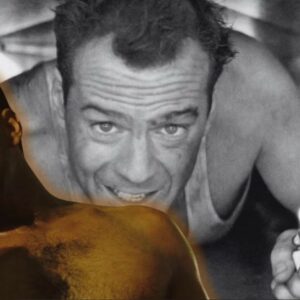Brad Pitt is a name that resonates with Hollywood stardom and cinematic excellence. Known for his chiseled features and charismatic screen presence, Pitt’s journey from a struggling actor to one of the industry’s biggest stars is a testament to his immense talent and relentless dedication. In this article, we explore how Brad Pitt navigates the audition process and secures his place in films and TV shows, delving into his early days, the evolution of his career, and his approach to securing coveted roles.
1. The Early Days
Brad Pitt’s story begins in the heartland of America. Born William Bradley Pitt on December 18, 1963, in Shawnee, Oklahoma, he grew up in Springfield, Missouri. Pitt attended the University of Missouri, where he earned a degree in Journalism with a focus on advertising. His passion for acting led him to move to Los Angeles shortly after graduation, where he faced the harsh realities of a competitive industry.
In the early days of his career, Pitt worked various odd jobs to make ends meet, including driving a chauffeur for a limousine company and working as a set dresser. These experiences were far removed from the glamorous world of Hollywood, but they provided him with the resilience and determination needed to succeed in the industry.
Pitt’s early acting credits include small roles in television shows such as “Dallas” and “Growing Pains.” However, it was his role in the 1991 film “Thelma & Louise” that marked the beginning of his rise to fame. Playing the charming drifter J.D., Pitt’s performance was a breakout moment, earning him widespread recognition and establishing him as a promising actor.
2. The Audition Process
Securing a role in Hollywood often involves a rigorous audition process, and Brad Pitt is no exception. The journey from audition to landing a role is a complex one, involving several stages and a great deal of preparation.
a. The Initial Audition
The initial audition is typically a chance for actors to showcase their skills and make a strong impression on casting directors. For Brad Pitt, this phase involves preparing monologues, studying the script, and understanding the character’s motivations and background. Pitt’s dedication to this process is evident in his thorough preparation and commitment to delivering a memorable performance.
b. Callback Auditions
If an actor impresses during the initial audition, they may be called back for a second round. Callback auditions are often more intensive, with actors performing additional scenes or participating in chemistry reads with other actors. For Pitt, this stage involves not only showcasing his acting prowess but also demonstrating his ability to work well with others and fit into the ensemble cast.
c. Screen Tests
Screen tests are a crucial part of the audition process, providing a glimpse of how an actor will appear on screen in the final product. During screen tests, actors perform scenes from the script while being filmed. This allows directors and producers to assess how well the actor embodies the character and how their performance translates on camera. Brad Pitt’s screen tests are often marked by his ability to bring depth and authenticity to his roles, making him a standout choice for many projects.
d. Final Selection
The final selection process involves a series of discussions and evaluations by producers, directors, and other key stakeholders. Pitt’s track record of delivering compelling performances and his strong screen presence often play a significant role in his successful selection for roles. Additionally, his reputation as a dedicated and professional actor further enhances his appeal to filmmakers.
3. The Evolution of Brad Pitt’s Career
Brad Pitt’s career has undergone significant evolution since his early days in Hollywood. From playing supporting roles to leading major films, his journey is a testament to his versatility and growth as an actor.
a. The Rise to Stardom
Following his breakout role in “Thelma & Louise,” Pitt continued to build on his success with a series of high-profile roles. Films such as “A River Runs Through It” (1992) and “Legends of the Fall” (1994) showcased his ability to handle diverse characters and solidified his status as a leading man. His performances during this period were marked by a combination of charisma, emotional depth, and impressive range.
b. The Transition to Character Roles
As Pitt’s career progressed, he began to explore more complex and unconventional characters. Movies like “Fight Club” (1999) and “Se7en” (1995) demonstrated his willingness to take on challenging roles and push the boundaries of his craft. Pitt’s ability to embody a wide range of characters, from the intense and brooding to the charming and humorous, further established him as one of Hollywood’s most versatile actors.
c. The Critical Acclaim
Pitt’s career reached new heights with a series of critically acclaimed performances. His role in “Moneyball” (2011) earned him an Academy Award nomination, and his portrayal of a World War II soldier in “Fury” (2014) was praised for its intensity and authenticity. Pitt’s dedication to his craft, including extensive research and preparation, contributed to the success of these performances.
d. The Producer’s Role
In addition to his acting career, Brad Pitt has made significant contributions as a producer. Through his production company, Plan B Entertainment, Pitt has been involved in a range of successful projects, including “12 Years a Slave” (2013) and “The Big Short” (2015). His role as a producer reflects his commitment to storytelling and his desire to support and collaborate with talented filmmakers.
4. Brad Pitt’s Approach to Roles
Brad Pitt’s success in landing and excelling in roles can be attributed to his unique approach to acting and his dedication to his craft. Several key factors contribute to his ability to nail his roles every time:
a. In-Depth Character Research
Pitt’s commitment to understanding his characters is a cornerstone of his approach. He invests time in researching the background, motivations, and psychological nuances of the characters he portrays. This meticulous preparation allows him to bring authenticity and depth to his performances, creating memorable and compelling portrayals.
b. Collaboration with Directors
Pitt’s collaborative approach with directors is another crucial aspect of his success. He values the input of directors and is open to their vision for the character and the film. This collaborative spirit enables him to align his performance with the overall creative direction of the project, resulting in a cohesive and impactful final product.
c. Physical and Emotional Preparation
Brad Pitt often undergoes rigorous physical and emotional preparation for his roles. Whether it’s undergoing a physical transformation for a specific character or delving into the emotional complexities of a role, Pitt’s dedication to preparation ensures that he delivers a performance that resonates with audiences. His commitment to embodying the physical and emotional aspects of his characters contributes to his success in securing and excelling in diverse roles.
d. Flexibility and Versatility
One of Brad Pitt’s defining qualities is his versatility as an actor. He is willing to take on a wide range of roles, from action-packed thrillers to introspective dramas. This flexibility allows him to showcase his range and adapt to different genres and storytelling styles, making him a sought-after talent in the industry.
5. The Impact of Brad Pitt’s Performances
Brad Pitt’s performances have had a lasting impact on the film industry and popular culture. His ability to bring depth and authenticity to his roles has garnered acclaim from critics and audiences alike.
a. Cultural Influence
Pitt’s roles have often become iconic, influencing popular culture and leaving a lasting impression on audiences. Characters like Tyler Durden in “Fight Club” and Lt. Aldo Raine in “Inglourious Basterds” have become cultural touchstones, contributing to the film’s impact and relevance.
b. Awards and Recognition
Brad Pitt’s performances have earned him numerous awards and accolades. He has received multiple Golden Globe Awards, Academy Award nominations, and other honors throughout his career. His achievements reflect the high regard in which he is held by the industry and his peers.
c. Legacy and Continued Success
Brad Pitt’s legacy in Hollywood is marked by his continued success and relevance. His ability to adapt to changing industry trends and remain a prominent figure in the entertainment world speaks to his enduring talent and dedication.
Conclusion
Brad Pitt’s journey from screen tests to stardom is a remarkable story of talent, perseverance, and dedication. From his early days in Hollywood to his current status as one of the industry’s leading actors, Pitt’s career is a testament to his ability to excel in a competitive and ever-evolving field. His approach to securing roles, including his meticulous preparation and collaborative spirit, has contributed to his success and enduring impact on the film industry. As Brad Pitt continues to take on new challenges and deliver exceptional performances, his legacy as one of Hollywood’s most accomplished actors remains firmly intact.





